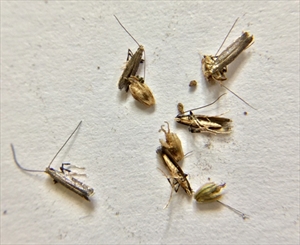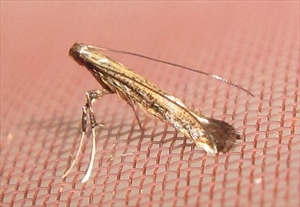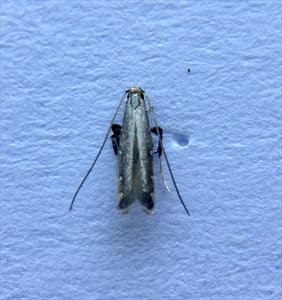Cowpea leafminer
Pacific Pests, Pathogens, Weeds & Pesticides - Online edition
Pacific Pests, Pathogens, Weeds & Pesticides
Cowpea leafminer (378)
Phodoryctis caerulea. It was previously known as Acrocercops caerulea, and it has been recorded as Phodoryctis centrometra from Fiji. It is a moth of the Gracillariidae.
Distribution uncertain. CABI has unconfirmed reports of Asia (India and Malaysia) and Wikipedia reports its presence in Indonesia, Sri Lanka, Japan, and Taiwan. It is recorded from Australia, Fiji, Guam, Solomon Islands, and Tonga.
Cowpea (Vigna unguiculata spp. unguiculata). It is also known from several other edible legumes, e.g., black gram (Vigna mungro), broad bean (Vicia faba), French bean (Phaseolus vulgaris), yardlong bean (Vigna unguiculata spp. sesquipedalis), mungbean (Vigna radiata), soybean (Glycine max), and ground-cover legumes, e.g., Centrosema, Pueraria, as well as fodder legumes, e.g., Crotalaria, and weeds, e.g., beach morning glory.
The larva of the moth does the damage burrowing in the upper surface of the leaf. At first, the larva makes a narrow winding snake-like mine, at the end of which is a large conspicuous blotch, with a thin translucent covering (Photos 1&2).
The immature larva is flattened, carrot-shaped, yellow, and has a row of golden dots on each side of its back. The head is triangular. When mature, the larva is 4.5 mm long, bright red, with a golden-brown head. The pupa develops inside a flat silky cocoon. Pupae are found on crop plants as well as weeds.
The adult moth is 3.5 mm long, with a dirty-cream body, and smoky forewings (Photos 3-5). The antennae are longer than the wings (Photos 4&5). The end of the wing are fringed and upturned. The first two pairs of legs are well-developed, the upper parts are black, and they hold the insect at a steep angle when at rest (Photo 4).
The leafminer survives as pupae in plant remains, in soil after harvest or on weeds.
Details of the impact of this leafminer are unknown. In Fiji, it is said that cowpeas are badly affected, and damage increases with age of the crop. In Australia, where it has been present for 20 years or more, it has not been reported by growers as a significant pest.
Look for the mines which begin as thin trails and expand into large blotches. Look for the smoky grey forewings with pale markings on the front edge of the forewing of the adult, which seem to be distinctive of the cowpea leafminer.
CULTURAL CONTROL
During growth:
- Squash the mines between finger and thumb to kill the larvae if the number of mines is small. Do this as soon as the mines are seen.
- If the number of mines is too large to squash, remove the infested leaves with mines, as soon as they are seen, and burn them.
- Do not plant new gardens next to those with leafminer damage.
After harvest:
- When plants come to the end of their usefulness, pull them out and burn them. Do not leave to breed leafminers to infest healthy plants.
CHEMICAL CONTROL
Chemical control is difficult because the larvae are protected inside their mines. Also, insecticides are likely to destroy natural enemies, and this can lead to outbreaks of other insects, and also mites.
- However, if pesticides are required, use white oil (made from vegetable oils), soap solution, or horticultural oil (made from petroleum) (see Fact Sheet no. 56).
- White oil:
- 3 tablespoons (1/3 cup) cooking oil in 4 litres water.
- ½ teaspoon detergent soap.
- Shake well and use
- Soap:
- Use soap (pure soap, not detergent).
- 5 tablespoons of soap in 4 litres water, OR
- 2 tablespoons of dish washing liquid in 4 litres water.
- White oil:
- Commercial horticultural oil can also be used. White oil, soap and horticultural oil sprays work by blocking the breathing holes of insects causing suffocation and death. Spray the undersides of leaves; the oils must contact the insects. A second application of soap or oils may be necessary after 3-4 weeks. It is important to test whether soap, white oil or horticultural oil damage leaves by spraying a single plant before spraying the rest.
Alternatively, use:
- Plant-derived products (botanicals), such as neem, derris, pyrethrum and chilli (with the addition of soap). PDPs are useful here as they are usually broken down by sunlight within 3 days of application.
- Note, a variety of Derris, brought many years ago to Solomon Islands from Papua New Guinea, is effective as a spray. It contains rotenone, an insecticide, so it should be used with caution. There may be varieties of Derris (fish poisons) in your country that can be tried (see Fact Sheet no. 56).
- Synthetic pyrethroids are likely to be effective against leafminers, as are systemic products e.g., imidacloprid. (Note, in April 2018, the European Union banned the three main neonicotinoids - clothianidin, imidacloprid and thiamethoxam - for all outdoor use.)
- If any of these synthetic pesticides are used, it is important to follow the instructions on the label, especially the with-holding period; this is the number of days between last the application of the spray and the harvest of the leaves.
____________________
When using a pesticide, always wear protective clothing and follow the instructions on the product label, such as dosage, timing of application, and pre-harvest interval. Recommendations will vary with the crop and system of cultivation. Expert advice on the most appropriate pesticides to use should always be sought from local agricultural authorities.
AUTHOR Grahame Jackson
Information from Swaine G (1971) Agricultural Zoology in Fiji. Her Majesty's Stationery Office. London; Photos 1-3&5 Mani Mua, SPC. Sigatoka Research Station, Fiji. Photo 4 Wikipedia. (https://en.wikipedia.org/wiki/Phodoryctis_caerulea#/media/File:Phodoryctis_caerulea.jpg).
Produced with support from the Australian Centre for International Agricultural Research under project HORT/2016/185: Responding to emerging pest and disease threats to horticulture in the Pacific islands, implemented by the University of Queensland and the Secretariat of the Pacific Community.








